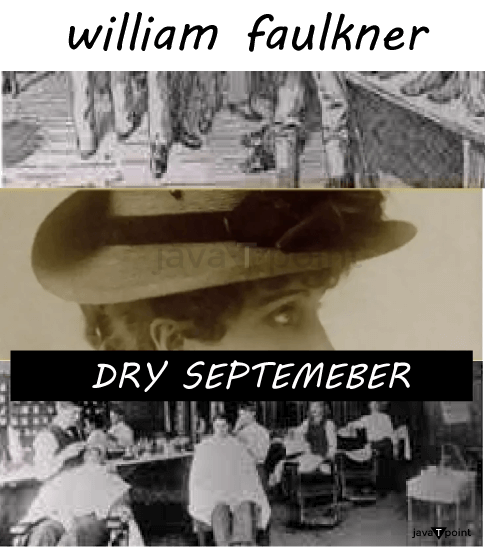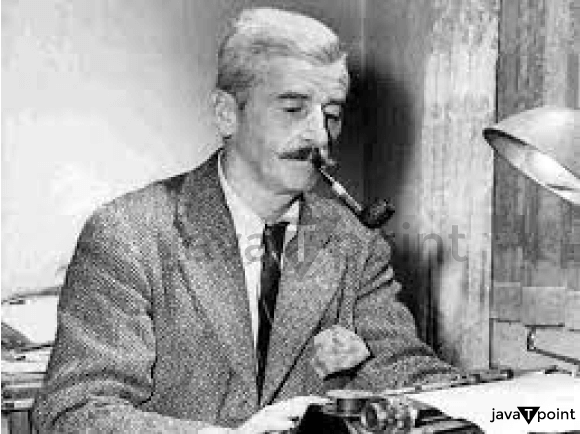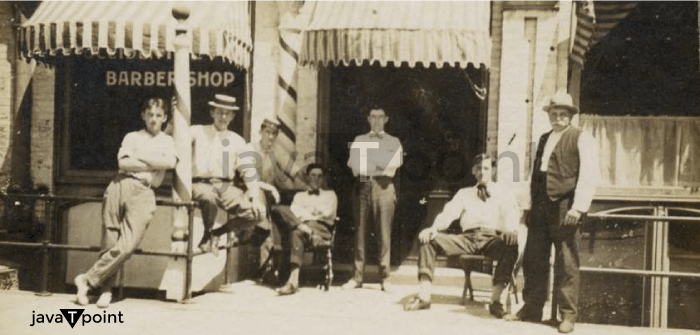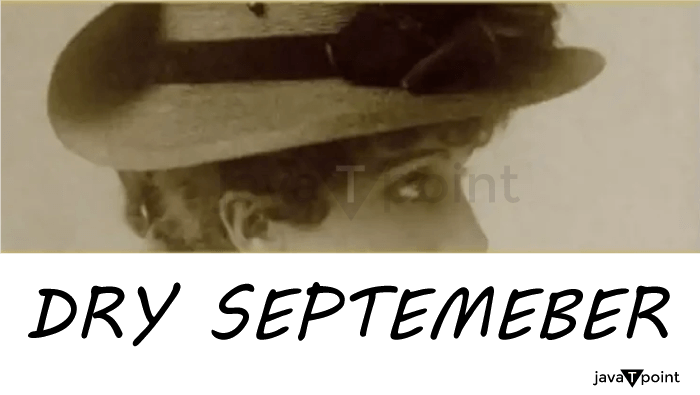Dry September SummaryIntroductionThe short tale "Dry September" was written by American author William Faulkner in 1931. This story was written during the Modernism, Southern Renaissance period. A white woman accuses an African-American man of attacking her in the story set in the American South, one hot and dry September. The white men in the town then organize a mob to pursue the man. They chase the man with horrible results, despite the town barber's warnings to be cautious. Like all his writing, Faulkner's Dry September story raises several significant yet challenging issues. 
Historical Background of the StoryThe American South had fast social change and moderate economic development throughout the first half of the 20th century. African Americans, who had only recently been emancipated from slavery and were still regarded as second-class citizens by the majority white population, were still highly dependent on their labor as the Southern economy slowly recovered from the devastation of the Civil War. In what was known as the Great Migration, many black men and women migrated north because they were unable to vote, frequently the victims of horrific violence, and denied access to quality education. Due to drought conditions from 1934 through 1939, the southern economy suffered even more during the Great Depression, resulting in hundreds of thousands of Americans being unemployed in this predominantly agricultural region. About the WriterWilliam Faulkner was born in New Albany, Mississippi, in 1897 and spent his early life in Oxford. Faulkner, although a gifted boy who could read before entering school, did not complete high school. He also dropped out of college in 1920 after joining the University of Mississippi in 1919. Faulkner started writing poetry and fiction after being inspired by Mississippi's history and the tales his family had told him. He was especially affected by his mother, grandmother, and long-term African American nanny, whose experiences shaped his writing's frequent examination of sexuality and race. He relocated to New Orleans, Louisiana, in 1925, when he authored and released his first book, Soldiers' Pay. In 1929, Faulkner wed Estelle Oldham, whom he had met as a student at Oxford. 
He wrote several books and short tales but struggled to support himself as a writer. In 1932, he and Oldham relocated to Culver City, California, where Faulkner found success as a screenwriter in Hollywood until the late 1950s. Faulkner, who was awarded the Pulitzer Prize twice for his books A Fable and The Reivers, also received the 1949 Nobel Prize in Literature. At 64, William Faulkner suffered a heart attack and passed away. He had written 13 novels and a large number of short stories. ThemeWilliam Faulkner's tale "Dry September" central idea centers on the pernicious effects of bigotry, mob mentality, and rampant violence. The narrative examines racism, sexism, and social injustice pervasive in the Southern United States during the beginning of the 20th century. Faulkner depicts a little Southern town where racial hatred and gossip are rampant. The plot centers on the catastrophic events after a rumor about Will Mayes, a black man supposedly assaulting a white woman, goes viral. The narrative emphasizes the dangerous repercussions of bigotry and the negative results of mob mentality. The destructive power of racism is one of the main topics. In Faulkner's depiction of a community, Faulkner shows how racial prejudices and stereotypes foster a climate of mistrust and hostility. The town's residents make snap decisions and take action in response to unfounded rumors without considering the facts or the repercussions of their choices. The story highlights how institutional racism permeates society and dehumanizes African Americans, resulting in an innocent man's unfair punishment. Mob mentality's impact is a further important theme. Faulkner uses violence and irrationality as examples of how a generalized feeling of rage and bitterness can turn violent. The villagers form a mob that strives to dispense justice independently, motivated by their beliefs and a shared feeling of self-righteousness. Will Mayes was tragically and senselessly killed because of their lack of regard for justice and reason due to their mob mentality. The idea of complicity and silence is also explored in the narrative. Faulkner depicts those aware of the injustice occurring yet choose to say nothing or participate. They remain silent because there is a general lack of interest in addressing racial inequity and upsetting the status norm. The narrative critique the effects of silence in the face of injustice and the complacent acceptance of discrimination. The story "Dry September" explores prejudice, mob mentality, and the destructive effects of unbridled violence. The story by Faulkner is a potent indictment of the racial and social inequities of the day, emphasizing the terrible effects of bigotry and the necessity of combating prejudice in society. SummaryThe opening scene of the short story "Dry September" depicts the imaginary city of Jefferson under the weight of an awful dry summer heat. The past two months have passed without rain; everything is dry and unpleasant. A rumor of an alleged sexual assault on a white woman, Minnie Cooper, a single woman in her late 30s, by a black man, Will Mayes, who is the watchman of an ice factory, is discussed by a group of males at a barbershop. None of them are aware of what occurred. They argue about certain aspects of the accused person and victim. The truth is still unveiled, but the problem is that no one seems to care about it, and the men of the town are out to defend the honor of a Southern white woman. However, the shop barber believes that Mayes is not guilty of the crime, and he tries to persuade others about it, but all the other men do not agree with his opinion and start arguing with the barber. It is disgusting to think this man would be hurt without knowing the full story. The South operated this way, as Faulkner makes clear in many of his works, including "Dry September." 
At this point, John McLendon, a stereotypical disparaging Southerner, enters the barbershop. He is harmful because he acts on his opinions and seeks an excuse to murder a black man because he is a racist. McLendon is already determined that Will Mayes is convicted of assault and plans to murder him. He criticizes the rest of the men for being lazy citizens. In addition, McLendon has no time for more information or argumentation. He soon creates a division by announcing that they are all either supporting or opposing him, and the majority of them show up to join him. McLendon's aggressive disposition affects everyone in Jefferson, both those who contribute to his ferocity and victims. McLendon's brutality was most likely perpetrated by someone else before him. Given his anger towards his wife in the final scene, it is possible to say that McLendon has aggression and control issues, which typically appear in the early years of childhood, according to Freudian theory. McLendon and a group of men then go to find Mayes. McLendon carries a gun in his pocket. He doesn't care if the crime was done; he thinks he should set a precedent before one of their white women gets harmed. The barber thinks that the men will kill Mayes, and he cannot let that happen, so he rushes behind them. Faulkner now presents Minnie Cooper in the tale. He portrays her as being in her late thirties and living with her disabled mother and elderly aunt. She rests on a porch swing every morning until the afternoon cools, then travels downtown with pals to shop but never buys anything. In her youth, she was thought to be attractive and desirable. As she grew older, she saw all of her friends marry. She was tempted for a short time by a local cashier and widower who had delivered the town's first car. He moved to Memphis for a better job, only to come back for an annual bachelor's club Christmas party. The other ladies inform her about his visits, and a young soda fountain clerk buys her whisky out of pity in the evening. However, Minnie still spends her evenings downtown, where most people no longer notice her. While still hoping to stop the other guys from hurting anyone, Hawkshaw comes across the men as they are searching for Will Mayes and joins them. After waiting for a second vehicle, McLendon drives the two vehicles as they leave town. The other men are urged to act on time by Hawkshaw. They disregard him and proceed to the ice factory, where night watchman Will Mayes is employed. On a pitch-black night, they leave the cars parked and look for Mayes. After reaching the ice factory where Mayes works, they bring him outside, handcuff and beat him, and then place him in the backseat next to Hawkshaw. As the men drive to a deserted part of town, Mayes tries to speak to the men and insists on his innocence, but they ignore him. Hawkshaw begs McLendon to let him out of the car because he feels dizzy, but he is unsuccessful. After opening the door, he leans out of the moving car. As the car passes him on its way back to town, Hawkshaw strolls along the road while hiding in a ditch. Now the story's focus is moved to Minnie again; she is getting ready for the evening while experiencing a slight fever. Her pals enquired about the specifics of the alleged incident. They tell her that when she feels strong again, she must tell them about the incident and everything that Mayes did and said to her. Despite feeling poorly, she continues to walk downtown with her companions. Everyone on the street watches Minnie closely; she trembles and walks slower. The people on the street start murmuring, seeing her, and the men are taking off their hats. When they arrive in the town square, they discover no Black men. The rumor that McLendon and his group had victimized Mayes in retaliation for his alleged crime has gained traction. When Minnie walks into the theatre, and the film starts, she laughs hysterically. Her friends drag her outside, where she continues to laugh in the street. She is then taken home, undressed, and placed in bed with an ice pack before they make a doctor's appointment. One of her friends felt sorry for her, but the other questioned whether anything had actually happened. In the last scene of "Dry September", Faulkner focuses on McLendon again. He writes that when in the midnight returns to his house, which he has newly bought, he finds his wife awake, and this makes him furious. She explains to him that the heat is keeping her from sleeping, but McLendon takes her and throws her across the chair while verbally abusing her and only half-hitting her. Then, he walks away, removes his shirt, keeps his gun on the table beside the bed, and sits on the back porch. He's panting and dripping with sweat. We can only presume that he and the other men killed Will Mayes, who was most likely innocent, because everything around him appears silent. The final scene is puzzling. The author Faulkner raises many queries in the reader. AnalysisBlack connections with the white community are a topic that "Dry September" focuses on and that many writers of Faulkner's era also decided to comment on. Vitriated, a synonym for corrupt, perverted, debauched, debased, and degraded, is how Faulkner defines the atmosphere. The South's inhabitants, who are warped and vitiated in thought and deed, are represented by the air. The weather is held responsible throughout the narrative, and Faulkner frequently highlights its foreboding presence. The title overshadowed the plot. It hasn't rained for about two months. The weather is erratic and unpredictable. It is one of the most destructive forces on the planet and has the potential to be beautiful as well as powerful. No one in the narrative tries to confirm or learn more about the reality of the incident. Instead, most men simply characterize it as a situation in which a black man is victimizing a white woman and endangering the historically pervasive racial borders. The barber, Hawkshaw, focuses on Mayes' reputation and character to establish himself as a sane and moral man. However, as evidenced by their proposal that Hawkshaw migrates north, the other men see this support of a black guy as a violation of their identity as southern white males. Faulkner emphasizes Minnie's outer look throughout the story to show that, in this society, that is all that matters. In addition, Faulkner discusses Minnie's single status and how single women were perceived in the South during his time. Women were supposed to get married; therefore, it was a red flag when they didn't. At that time, female singleness could not be considered "okay." The status of women in society was rigid. McLendon is seen not to care whether the rumor is real or not and to be eager to utilize this occasion to deliver a message to the black men of Jefferson, highlighting that the men's activities are motivated by prejudice rather than a sincere desire for justice. The soldiers had become enraged and crazy due to the sweltering heat and McLendon's zeal. 
In addition, Faulkner included the barber's temporary error, demonstrating that everyone is susceptible to persuasion and that there are no exceptions. Peer pressure is frequently to blame in the circumstances like these. Even in the dry September, McLendon is wet. It could be because his hatred and rage have persisted. In the crowd, he is distinctive. The final scene usually introduces the reader to a Faulkner favorite: the way of life in the South during and after the war. The author needs to answer whether the rumor is real or made up. Except for the barber, who serves as the story's voice of reason, we need further information or facts that would convince us that Mayes is not guilty of the crime for which he is being accused. However, it doesn't seem like innocence or actuality are relevant; rather, the severity of the man's aggression and punishment are what matter. ConclusionThe narrative demonstrates how our interactions impact one another's lives. Our deeds impact how we live and relate to one another daily. Violence only results in additional violence. This short story, "Dry September," comments on how different viewpoints relate to one another and the repercussions of breaking social norms. Race is another component that Faulkner includes. When practically the entire white population in the South was out to get you because of your color, we see how tough it was to be a black man. A compelling narrative like "Dry September" can help society see the issues under the surface.
Next TopicFrench Revolution Class 9
|
 For Videos Join Our Youtube Channel: Join Now
For Videos Join Our Youtube Channel: Join Now
Feedback
- Send your Feedback to [email protected]
Help Others, Please Share









